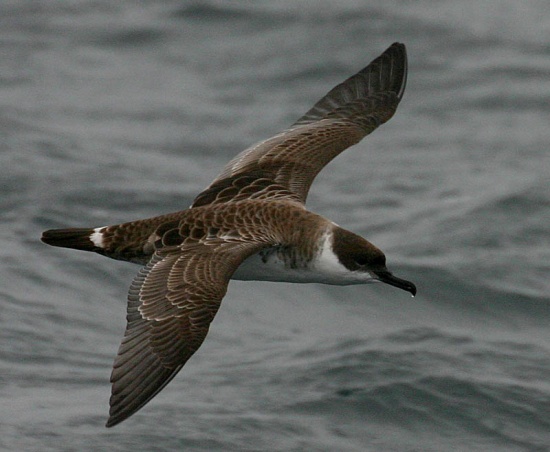Alternative name: Greater Shearwater
- Puffinus gravis
Identification
Length 18" (46 cm), wingspan 42-44" (107-112 cm)
Gray-brown upper parts with dark cap, U-shaped white band at base of tail. White of underside extends up sides of neck, sometimes across nape. Thin dark bill.
Similar Species
Cory's Shearwater is about the same size with heavier yellow bill, dark head, clean white underwing, and blunt broad wings.
Manx Shearwater is much smaller with no white collar, no white tail band, totally white belly and undertail coverts, and much more blackish.
Audubon's Shearwater is much smaller with short stubby wings, no white collar, no white tail band, long tail, dark undertail coverts, and white spot near eye.
Distribution
Atlantic Ocean from Cape Horn northward. Annual migration completes a loop from the eastern seaboard of South and then North America before crossing the Atlantic in August. It can be quite common off the south-western coasts of Great Britain and Ireland before flying south along the eastern side of the Atlantic upon the approach of the northern winter.
Taxonomy
Habitat
Pelagic - open ocean, more likely in the Atlantic than other oceans. Breeds on Nightingale Island, Inaccessible Island, Tristan da Cunha, and Gough Island.
Behaviour
A gregarious species, it can often be seen in large numbers from ships or headlands.
Diet
Feeds on fish and squid, which it catches from the surface or by plunge-diving. It readily follows fishing boats, where it engages in noisy competition for spoils.
Breeding
Lays one white egg in a small burrow or in the open grass, which it visits only at night to avoid predation by large gulls.
Vocalisation
Call: A piercing eeyah usually given when resting in groups on the water.
References
- Clements, J. F., T. S. Schulenberg, M. J. Iliff, B.L. Sullivan, C. L. Wood, and D. Roberson. 2013. The eBird/Clements checklist of birds of the world: Version 6.8., with updates to August 2013. Downloaded from http://www.birds.cornell.edu/clementschecklist/download/
Recommended Citation
- BirdForum Opus contributors. (2024) Great Shearwater. In: BirdForum, the forum for wild birds and birding. Retrieved 13 May 2024 from https://www.birdforum.net/opus/Great_Shearwater





